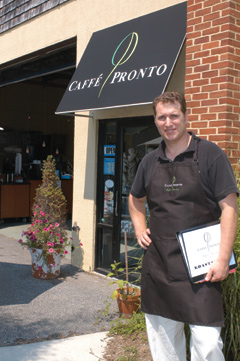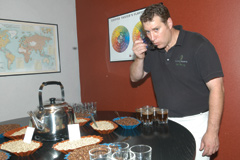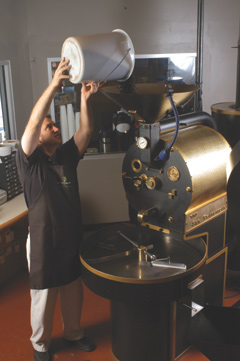That Morning Cuppa Joe
Is More Complicated Than You Think
By Cindy Edwards
It's no secret that coffee has become a cultural icon. Espresso, latte, cappuccino and frappuccino are familiar words today, and these java concoctions have become a part of our daily grind. Coffee is officially the number one social drink of choice in the United States, and we are by far the largest coffee importer in the world. Retail value of coffee in this country alone is estimated at $20 billion-and get this-coffee is a world commodity that is second only to oil. These reasons alone warrant a deeper look into the world of coffee.
Now combine the facts with a healthy curiosity about just what happens before the aromatic beans end up in our favorite cuppa joe, who it affects along the way and what sets a quality coffee apart from the others, and you have the "grounds" for this article.
 Coffee roaster Vincent Iatesta is the founder and president of Caffé Pronto Coffee Roastery located here in Annapolis, and his brand of specialty coffee is a creation of excellence. "I created Caffé Pronto to be a high-end specialty provider because that's what I personally want in a coffee-coffee is all about what's inside the cup, and Caffé Pronto is about being the best I can be." His passion for the full experience of coffee and its outreach is palpable. Coffee roaster Vincent Iatesta is the founder and president of Caffé Pronto Coffee Roastery located here in Annapolis, and his brand of specialty coffee is a creation of excellence. "I created Caffé Pronto to be a high-end specialty provider because that's what I personally want in a coffee-coffee is all about what's inside the cup, and Caffé Pronto is about being the best I can be." His passion for the full experience of coffee and its outreach is palpable.
Iatesta takes us on a journey "from bean to cup," and says that, "Coffee beans come to life as flowers that grow on the branches of trees similar to evergreens-[they last a little more than a day]. These flowers give way to green cherries that grow to be about the size of cranberries and turn red when they're ready to be picked, but they don't all ripen at the same time," explains Iatesta. "It's not uncommon for flowers, green cherries and ripe red cherries to occupy the same branch. For that reason, our suppliers handpick their beans and sometimes harvest the same plant three, four or five times during one season in order to obtain the ripened cherries."
After harvesting, coffee cherries are processed. Most coffees are patio-dried in the sun. Coffee has been processed this way for centuries. Another option is "wet" processing. In either case, afterwards, they are hulled, and the end result is a bean that is green in color.
All of this takes place on coffee farms or estates known in the coffee industry as "origins," says Iatesta. "We currently work with about 20 origins that are located in Brazil, Colombia, Panama, Costa Rica, Guatemala, Tanzania, Kenya, Ethiopia, Yemen, Papua, New Guinea, Sumatra, Java and Sulawesi. We also have exotics like Jamaica Blue Mountain and Hawaiian Kona. Each has its own distinctive flavor characteristics."
As for "sustainable" coffees (those grown in a manner that sustains the environment and the communities where the coffee is grown), Iatesta says, "We certainly try to support them, therefore we carry organics from Colombia, Guatemala and Sumatra. We offer shade grown, fair trade and bird-friendly varieties too, but I never choose a sustainable coffee just for the sake of being a sustainable-it has to be good. Even though they're sustainable, they have an obligation to make sure they are achieving high quality in all areas. Quality is paramount."
 And herein lies a dimension about which many may be unaware. "Sometimes there's an unintended negative perception associated with coffees that are not labeled as sustainable or fair trade," Iatesta explains. "It doesn't necessarily mean they do not have a positive impact at origin. We carefully evaluate the farms, mills and importers of the coffee we use. We make one or two origin visits each year and develop a close relationship with our suppliers. We talk with the growers, farmers and all of the employees to be sure they're happy. We will implement anything that improves quality." And herein lies a dimension about which many may be unaware. "Sometimes there's an unintended negative perception associated with coffees that are not labeled as sustainable or fair trade," Iatesta explains. "It doesn't necessarily mean they do not have a positive impact at origin. We carefully evaluate the farms, mills and importers of the coffee we use. We make one or two origin visits each year and develop a close relationship with our suppliers. We talk with the growers, farmers and all of the employees to be sure they're happy. We will implement anything that improves quality."
As Iatesta shares photos of Finca Dos Marias in the San Marcos region of Guatemala, he explains further. "This farm not only pays good wages, but deeds land to its employees and provides them with health care too. They built an on-site school and church for employees, and Finca Dos Marias is also committed to the preservation of its local rainforest and the wildlife like the Quetzal bird that resides within." How's that for positive impact?
After the beans are harvested, they are hand sorted, and that's where quality comes into play. "We specialize in Class One Specialty beans, and that represents only about seven percent of the world's harvest-all other coffees are below that grade. These beans are sorted by hand to ensure zero defects. Class One is the best that any particular origin or farm has to offer." These Class One beans are shipped to Iatesta in the states, warehoused in New Jersey, then delivered as needed to his location here in Annapolis.
As for the roasting, it's pure artistry. "I create my own recipes, roast profiles and blends. This is why roasting caters to my creative interest," says Iatesta. "We actually use all of our senses while roasting. We use our eyes to measure the color of the beans and our nose to smell the aroma; our ears because beans go through two cracks as the cell walls expand and burst. These three are very important measurements in determining when the beans are complete. When they're ready, we pour them onto a cooling tray where we can touch and taste them."
 His coffee roaster is a gorgeous black and brass handcrafted model called the San Franciscan. Iatesta's expression as he speaks about it is not unlike that of a proud parent. "The roaster was customized specifically for me and how I want to use it. It gives me the capability to roast 100 pounds of coffee per hour, and its features provide specific information so we can really customize the roast." Roasting days at Caffé Pronto are Mondays and Thursdays of each week. His coffee roaster is a gorgeous black and brass handcrafted model called the San Franciscan. Iatesta's expression as he speaks about it is not unlike that of a proud parent. "The roaster was customized specifically for me and how I want to use it. It gives me the capability to roast 100 pounds of coffee per hour, and its features provide specific information so we can really customize the roast." Roasting days at Caffé Pronto are Mondays and Thursdays of each week.
Also a part of the process is destoning and chaff removal. "The chaff of a coffee bean is similar to the skin on a peanut, and we collect it in the chaff cyclone," he explains. "Chaff is a good garden fertilizer for acid-loving plants like rhododendrons and hydrangea. We have a woman who comes and picks up the chaff each week for her garden." Iatesta also recycles all coffee grinds.
Next the coffee beans are bagged, and the specific roasting date is recorded on each label to ensure freshness. The packaging and logo were mindfully crafted, and Iatesta describes the presentation of both as "simple, elegant and beautiful."
An essential element for any connoisseur or authentic coffee roaster is to master a procedure known as "cupping," the art of tasting coffee. "Cupping occurs before we buy any coffee-and my brokers know I'm going to cup and evaluate every single coffee bean."
Iatesta is adamant about remaining unbiased during the process. "When we are cupping, we don't know which coffee is which, who the importer is or what the cost may be because I want to select the best. I'm not buying based on cost, I'm buying based on quality."
The method is far too complex to cover in detail in this article, but it starts with a "green inspection" whereby the 350-gram samples are inspected bean by bean to look for any defects or flaws, like chips, insect damage, fungus, blacks, immatures, quakers and floaters. Any of these could compromise consistency and quality.
Next, the beans are measured precisely, roasted in a miniature version of the San Franciscan, grinded methodically, poured into cupping glasses and strategically placed on the cupping table. And that's just the beginning.
Here's an abridged version of the rest of the cupping story, but please keep in mind that the procedure is actually performed in poetic cadence for each cupping glass on the table, and sometimes there are as many as 50. First, inhale deeply, smell the dry grounds, then add water just off a boil, let it sit until a cap (or crust) is formed on the top, take a cupping spoon, break the cap to release the aromas, let the grinds settle to the bottom, skim the crust off the top, use a cupping spoon to get a sample. Exhale. Slurp it in, let it spray all over the mouth and allow the aromas to travel up into the nasal cavity. Experience the sensations fully.
Next, each coffee is evaluated and rated on cleanliness, sweetness, acidity, mouth feel, flavor, aftertaste and balance. "The coffee is given an overall numeric score," Iatesta says, "and we select the top scores. The objective is to find the best and most unique coffee-something that's really going to blow people away."
Caffé Pronto also sets up wholesale accounts with independent coffee shops, hotels and restaurants and serves as a full service provider to them. "We develop close partnerships with our accounts and help them to grow and succeed in their business. We are dedicated to the adherence of principles that our company was founded on. At the top of that list is quality and service. After all, I can have the best coffee around, but if I don't have the best service, it's incomplete. So we work to maintain the best of both from every angle."
In a little over two years, Caffé Pronto has created a powerful brand that people have come to prefer. And because it's locally roasted, it's as fresh as it gets-hence the name. "Caffé with two 'ffs' is actually Italian, and Pronto of course means now," Iatesta explains. "The name represents the freshness and quality of the coffee since we don't stock any roasted inventory. It's all roasted fresh to order-so when we say Caffé Pronto-it's coffee now."
And so our journey is complete. Now, perhaps the next time we wake up and smell the coffee, we'll take a deeper look into the cup, more aware of what's inside. Sometimes it's the simplest of everyday intentions that enrich not only our own lives, but also the lives of those who are oceans away.
For more information, call Caffé Pronto at 410-626-0011 or visit www.caffepronto.com.
Back
|

